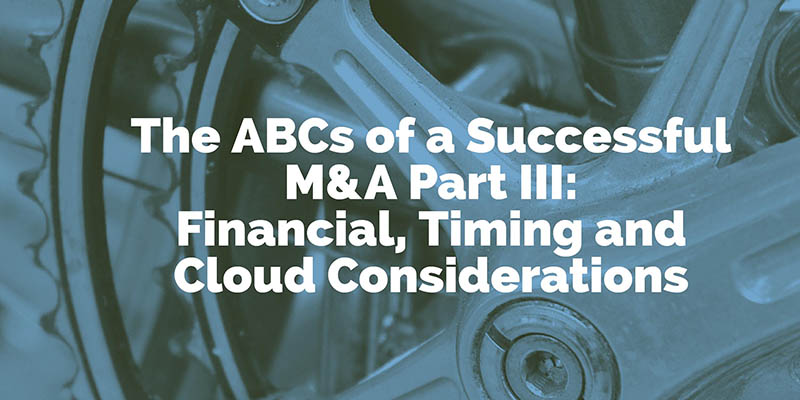Mergers and acquisitions aren’t easy: the failure rates fall between 70-90%, so anything and everything you can do to weigh the odds in your favor are critical, especially leveraging the cloud. In the first two parts of this trilogy, we’ve looked at reasons for M&As, the due diligence required, human resources implications, intellectual property, strategic partners and regulatory approval. For the finale, we’ll take a closer look at financial and timing considerations and why the cloud can be a difference maker.

You buy a company because you’re either looking to add — customers, markets and/or capabilities — or improve/replace — supply chain, costs and/or competition — but at a price that won’t create short or long-term problems. You need to consider what the company to be acquired is worth currently (assets and liabilities minus good will), what its foreseeable prospects are (fair market value), and what you will need to pay, including good will (purchase price).
Assets include cash and investments, plant and inventory. Liabilities include debt, taxes and pending legal issues. Unlike assets and liabilities, good will is an intangible, and therefore harder to evaluate. It includes brand, customer base relationships, human capital and intellectual property, i.e. patents.
For most acquisitions, it’s a case of 1 + 1 = 3, where 3 includes the premium that the sellers are looking for, and the price buyers will have to pay to conclude the deal. The purchase price premium can vary widely, depending upon a number of elements, including IP, shareholders (both yours and theirs) and competition. Typically the premium can be 15-30% on top of current revenues, but there have been M&As where the premium has been up to 10x or more. The recent NetSuite acquisition by Oracle for $9.3 billion represented 11x its trailing 12-month revenue of $846; and the other recent megadeal, SoftBank buying ARM for $32.4 billion, worked out to 20.9x trailing revenue for ARM.
Once you’ve determined the price, the next consideration is how you will pay for the acquisition: cash, stock, or debt (or a combination). The method selected should be determined by feasibility, your business strategy, and your market. In most cases, cash tends to be the least costly, with debt falling in between, and stock being the most expensive form of financing.
M&As are complex, and so are the timetables, from deciding to buy — or be bought — through the due diligence, acquisition and integration phases. Time can derail the process, with delays creating new issues and/or raising the price/costs.
Proper planning, realistic schedules and ensuring that the various deadlines are met can be critical to the success of the M&A. Typically an acquisition runs between 3-9 months, but they can be turned around much more quickly, or take considerably longer.
An M&A typically starts with determining your strengths and weaknesses, and deciding what you need to grow your company. Put together a list of potential acquisitions, narrow it down to one candidate, gauge their interest, sign a letter of interest (and confidentiality). After due diligence, you submit a purchase agreement, finalize details, close the deal, and proceed with the integration.
During this process you have to create a timetable with deliverables/objectives, responsibilities and oversights, along with options for dealing with unexpected issues and/or delays. Failing to proceed as expeditiously as possible can have negative implications for such elements as valuations, shareholders, morale, and market competition.
Getting the financing and timing considerations right are critical, but the cloud can make the M&A process a lot smoother, which can make it a lot more likely that it is a successful M&A. As part of the M&A process, IT must continue to provide the services and support required to keep the two businesses running while determining what economies and efficiencies are achievable post-acquisition.
Increasingly, the cloud is playing a bigger role in that process. IT dependent synergies have been found to be responsible for a large proportion (30 to 60%) of M&A benefits, but 70% of M&As fail to meet their synergy targets in the planned timeframe, according to IBM, which knows a thing or three about M&As.
Top cloud benefits for M&A
- achieving synergy more quickly: cloud enabled applications simplify portability, integration and deployment;
- lowering costs: the cloud can provide temporary burst capacity for the migration;
- increased financial flexibility: cloud provides a flexible cost model, allowing organizations to easily move between CAPEX and OPEX to impact EBITA and cash flow; and,
- simplifying changes: cloud simplifies the creation of APIs to hide the underlying complexity of multiple, overlapping systems.
Once all the homework, negotiation and deal conclusion comes the fun part, working on achieving your original objectives. Regardless of whether your objective was addition — i.e. new customers, or new offerings for existing customers — or subtraction — i.e. cutting costs and/or competitors — you need to move quickly and execute carefully. The odds are against a successful M&A, but the potential jackpot is clearly worth the time, effort and expense, when done right.


